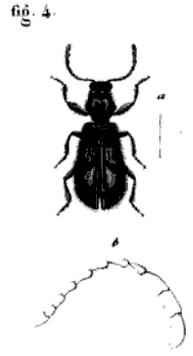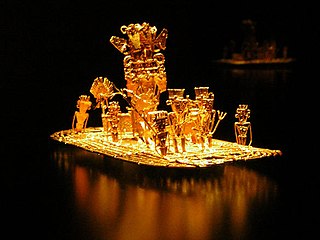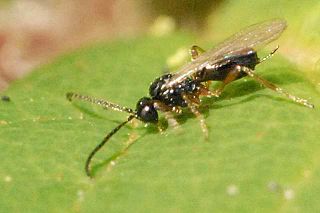
The Braconidae are a family of parasitoid wasps. After the closely related Ichneumonidae, braconids make up the second-largest family in the order Hymenoptera, with about 17,000 recognized species and many thousands more undescribed. One analysis estimated a total between 30,000 and 50,000, and another provided a narrower estimate between 42,000 and 43,000 species.

The Bogotá savanna is a montane savanna, located in the southwestern part of the Altiplano Cundiboyacense in the center of Colombia. The Bogotá savanna has an extent of 4,251.6 square kilometres (1,641.6 sq mi) and an average altitude of 2,650 metres (8,690 ft). The savanna is situated in the Eastern Ranges of the Colombian Andes.

Bacatá is the name given to the main settlement of the Muisca Confederation on the Bogotá savanna. It mostly refers to an area, rather than an individual village, although the name is also found in texts referring to the modern settlement of Funza, in the centre of the savanna. Bacatá was the main seat of the zipa, the ruler of the Bogotá savanna and adjacent areas. The name of the Colombian capital, Bogotá, is derived from Bacatá, but founded as Santafe de Bogotá in the western foothills of the Eastern Hills in a different location than the original settlement Bacatá, west of the Bogotá River, eventually named after Bacatá as well.

Microgastrinae is a subfamily of braconid wasps, encompassing almost 3,000 described species, with an estimated 30,000–50,000 total species. This makes it one of the richest subfamilies with the most species of parasitoid wasps.

Chingaza National Natural Park is located in the Eastern Ranges of the Colombian Andes, northeast of Bogotá, Colombia in the departments of Cundinamarca and Meta. The elevation in the park, to the east of the Altiplano Cundiboyacense, ranges from 800 metres (2,600 ft) to 4,020 metres (13,190 ft), and the temperature ranges from 4 to 21.5 °C. The park extends over the Cundinamarca municipalities La Calera, Fómeque, Guasca and San Juanito (Meta).
Muisca people are indigenous people in Colombia.

The Muisca Confederation was a loose confederation of different Muisca rulers in the central Andean highlands of present-day Colombia before the Spanish conquest of northern South America. The area, presently called Altiplano Cundiboyacense, comprised the current departments of Boyacá, Cundinamarca and minor parts of Santander.

Muisca is a genus of checkered beetles of the subfamily of Clerinae or Enopliinae. It is only known from two species, the type species, Muisca bitaeniata and Muisca cylindricollis. The genus was first described by entomologist Maximilian Spinola in 1844.

Muisca bitaeniata is the accepted type species of checkered beetles of the genus Muisca in the subfamily of Clerinae or Enopliinae. It was first described by entomologist Maximilian Spinola in 1844.

Huitaca or Xubchasgagua was a rebelling goddess in the religion of the Muisca. The Muisca and their confederation were a civilization who inhabited the Altiplano Cundiboyacense in the Andes. Huitaca has been described by the chroniclers Juan de Castellanos in his Elegías de varones ilustres de Indias, Lucas Fernández de Piedrahita and Pedro Simón.

The Muisca calendar was a lunisolar calendar used by the Muisca. The calendar was composed of a complex combination of months and three types of years were used; rural years, holy years, and common years. Each month consisted of thirty days and the common year of twenty months, as twenty was the 'perfect' number of the Muisca, representing the total of extremeties; fingers and toes. The rural year usually contained twelve months, but one leap month was added. This month represented a month of rest. The holy year completed the full cycle with 37 months.

Muisca religion describes the religion of the Muisca who inhabited the central highlands of the Colombian Andes before the Spanish conquest of the Muisca. The Muisca formed a confederation of holy rulers and had a variety of deities, temples and rituals incorporated in their culture. Supreme being of the Muisca was Chiminigagua who created light and the Earth. He was not directly honoured, yet that was done through Chía, goddess of the Moon, and her husband Sué, god of the Sun. The representation of the two main celestial bodies as husband and wife showed the complementary character of man and woman and the sacred status of marriage.

Muisca cuisine describes the food and preparation the Muisca elaborated. The Muisca were an advanced civilization inhabiting the central highlands of the Colombian Andes before the Spanish conquest of the Muisca in the 1530s. Their diet and cuisine consisted of many endemic flora and fauna of Colombia.
Pegoscapus bacataensis is a species of fig wasp in the genus Pegoscapus which is native to Colombia. It has an obligate mutualism with Ficus andicola, the fig species it pollinates. It was first described by Sergio Jansen and Carlos Sarmiento in 2008. The egg stage of Pegoscapus bacataensis is around 130 days, longer than other pollinating fig wasps.

Blacini is a tribe of braconid Parasitoid wasps. Formerly the subfamily Blacinae, this group was demoted to a tribe and placed within the Brachistinae based on molecular evidence in 2011.

Alabagrus texanus is a species of braconid wasp in the family Braconidae. It develops within the larvae of Herpetogramma theseusalis. Males emerge from pupation earlier than females. Females typically only mate once, whereas males mate more than once.

Alabagrus is a genus of braconid wasps in the family Braconidae. There are at least 100 described species in Alabagrus.
Hormius is a genus of parasitoid wasp in the subfamily Hormiinae first described by Christian Gottfried Daniel Nees von Esenbeck in 1818.










